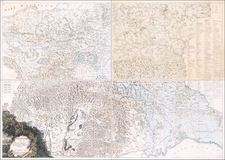Search
Stanisław Wawrzyniec Staszic was one of the leading lights of the European Enlightenment. He was extraordinary accomplished in many different disciplines, including geology, botany, philosophy, linguistics, literature, economics and religion, in addition the being one of Poland’s great political theorists and statesmen.
Staszic was born in 1755 in Piła, northwest Poland and educated at the Jesuit Academy in Poznań, where he was ordained a Catholic priest in 1774. From 1779 to 1781, Staszic continued his education at the College de France, studying physics and natural history under some of the greatest names of the French Enlightenment, notably including Georges-Louis Leclerc Buffon. Staszic would later translate Buffon’s L’Histoire Naturelle, générale et particulière, avec la description du Cabinet du Roi (1749-89), into Polish.
Returning to Poland in 1781, Staszic was employed as the tutor, and later senior councillor, to the Zamoyski Family, one of Poland’s most powerful and intellectually sophisticated noble clans. He also distinguished himself as the finest French-Polish translator of the era.
In the following years, Staszic became a major figure on the Polish political scene, one of the leaders of a group of young reformers who fought to save Poland from its state of terminal decline. His anonymously published Uwagi nad życiem Jana Zamoyskiego [Remarks upon the Life of Jan Zamoyski] (1787), brought him to light as one of the public intellectuals of Poland.
Staszic’s became one of the principal figures behind the creation of the Constitution of May 3, 1791, a highly enlightened, but ultimately ill-fated, document that called for the reformation of the Polish state in the direction advocated by the Remarks, and was a major backer of the Kościuszko Uprising (1794), a failed attempt to liberate Poland from foreign take-over.
Fearing reprisals from Prussian authorities, Staszic went into exile in Vienna, where he made a considerable fortune in the stock market, which allowed him to finance his subsequent scientific endeavors, including the work that led to the production of the present map.
He devoted much time to exploration of the geology of the Carpathian Mountains, making discoveries that were incorporated into the present map. In 1800, he was one of the founders of the of the Towarzystwo Przyjaciół Nauk, or TPN [Society of Friends of Science], the prestigious scholarly group that would later become the Polish Academy of Sciences.
In 1806, following an expedition to explore the geology of the Tatra Mountains, he created the manuscript for the present map, as well as the draft for the present geological profile of that mountain range.
In 1808, Staszic returned to the political scene, serving on the State Council of the Duchy of Warsaw, the short-lived quasi-independent state supported by Napoleon.
In 1815, Warsaw and much of Central Poland became ‘Congress Poland’, an autonomous region of the Russian Empire. While Staszic was a Polish nationalist, he was also a Pan-Slavist; controversially, he supported the new Russian-backed administration, seeing rule by fellow Slavs as far preferable to Prussian domination. This caused great offense to many Polish patriots, who henceforth saw him as at best a ‘flawed giant’, and at worst, a villain.
Staszic served as the Deputy Minister of Education of Congress Poland, where he initiated many highly regarded reforms to the school system and curricula. He subsequently became the Minister of Industry (1816-24), where he oversaw great advances in fields related to his geological discoveries, namely the mining, metallurgy, light manufacturing and ceramics industries. He was also the first figure to foresee the importance of coal in Poland’s industrial economy. Additionally, Staszic supported farming, founding the Hrubieszowskie Towarzystwo Rolnicze [Hrubieszów Agricultural Society] in 1816.

